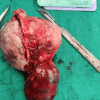A Rare Case of Bilateral Pheochromocytomas: Diagnostic and Surgical Challenges in a 38-Year-Old Female
- PMID: 40656287
- PMCID: PMC12255871
- DOI: 10.7759/cureus.85885
A Rare Case of Bilateral Pheochromocytomas: Diagnostic and Surgical Challenges in a 38-Year-Old Female
Abstract
Pheochromocytomas are rare tumors of the adrenal medulla, and bilateral involvement is especially uncommon in the absence of a hereditary syndrome. We present the case of a 38-year-old female who presented with bilateral flank pain, excessive sweating, and palpitations. Clinical examination and laboratory investigations revealed elevated blood pressure and markedly increased serum metanephrines and normetanephrines. Imaging identified large bilateral adrenal masses with features suggestive of pheochromocytomas. A multidisciplinary team opted for a staged surgical approach: a left adrenalectomy followed by a right cortical-sparing adrenalectomy. The patient was adequately prepared preoperatively with alpha- and beta-blockers to reduce the risk of intraoperative hypertensive crisis. Histopathology confirmed pheochromocytoma in both adrenal glands. Postoperative management included steroid replacement therapy and regular monitoring of adrenal hormone levels to assess the functionality of the remaining adrenal tissue. Genetic testing was offered to assess for underlying genetic causes, but was declined by the patient. This case illustrates the importance of individualized, multidisciplinary care in managing bilateral pheochromocytomas, with emphasis on preserving adrenal function and ensuring long-term surveillance.
Keywords: adrenal surgery; adrenal tumors; bilateral pheochromocytoma; catecholamine-secreting tumor; cortical-sparing adrenalectomy; hypertension; multidisciplinary approach; staged adrenalectomy.
Copyright © 2025, Khan et al.
Conflict of interest statement
Human subjects: Consent for treatment and open access publication was obtained or waived by all participants in this study. Conflicts of interest: In compliance with the ICMJE uniform disclosure form, all authors declare the following: Payment/services info: All authors have declared that no financial support was received from any organization for the submitted work. Financial relationships: All authors have declared that they have no financial relationships at present or within the previous three years with any organizations that might have an interest in the submitted work. Other relationships: All authors have declared that there are no other relationships or activities that could appear to have influenced the submitted work.
Figures





Similar articles
-
NIH state-of-the-science statement on management of the clinically inapparent adrenal mass ("incidentaloma").NIH Consens State Sci Statements. 2002 Feb 4-6;19(2):1-25. NIH Consens State Sci Statements. 2002. PMID: 14768652
-
Bilateral Pheochromocytoma with a Novel Pathogenic Variant in the MAX gene: A Case Report.J ASEAN Fed Endocr Soc. 2025 May;40(1):108-111. doi: 10.15605/jafes.040.01.16. Epub 2025 Apr 29. J ASEAN Fed Endocr Soc. 2025. PMID: 40416485 Free PMC article.
-
Case Report: Giant pheochromocytoma complicated by takotsubo syndrome: a case of emergency robot-assisted left adrenalectomy and multidisciplinary management.Front Oncol. 2025 Jun 16;15:1603477. doi: 10.3389/fonc.2025.1603477. eCollection 2025. Front Oncol. 2025. PMID: 40589642 Free PMC article.
-
Giant Pheochromocytoma With Non-classical Symptoms: A Case Report to Expand Clinical Awareness.Cureus. 2025 Jul 21;17(7):e88445. doi: 10.7759/cureus.88445. eCollection 2025 Jul. Cureus. 2025. PMID: 40842753 Free PMC article.
-
Pheochromocytoma associated with ectopic ACTH-producing tumor and hyper-interleukin-6emia: a case report with review of literature.Endocr J. 2025 Jun 2;72(6):743-750. doi: 10.1507/endocrj.EJ24-0459. Epub 2025 Feb 14. Endocr J. 2025. PMID: 39956584 Free PMC article. Review.
References
-
- Pheochromocytoma as a catecholamine producing tumor: implications for clinical practice. Zelinka T, Eisenhofer G, Pacak K. Stress. 2007;10:195–203. - PubMed
Publication types
LinkOut - more resources
Full Text Sources
